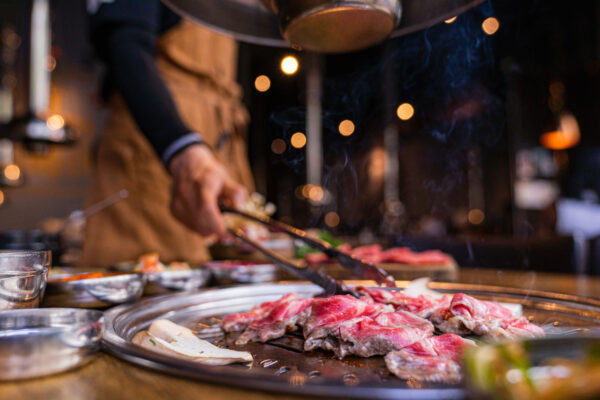The landscape of Asian cuisine in American restaurants is undergoing a rapid transformation, driven by consumer demand for authenticity and culinary specificity that signals exciting opportunities for restaurant operators nationwide.
The Authenticity Revolution:
Embracing Culinary Specificity
Asian food trends in the United States are evolving rapidly, with a growing focus on diverse cuisines, innovative pantry staples, and regionally authentic flavors. According to comprehensive menu analysis across U.S. chains and independent restaurants, this shift is dramatically reshaping the culinary landscape.
Today’s diners are seeking authentic experiences that celebrate the distinct characteristics of individual Asian cuisines rather than broad generalizations, creating unprecedented opportunities for specific regional specialties.
Current Asian Cuisine Popularity Rankings
Below are the specific cuisines driving this transformation:
| Thai cuisine | 53% of operators |
| Japanese cuisine | 48% of operators |
| Korean cuisine | 44% of operators |
| Indian cuisine | 37% of operators |
| Authentic/Regional Chinese | 28% of operators |
| Vietnamese cuisine | 23% of operators |
| Filipino cuisine | 10% of operators (fastest growing segment) |
This demonstrates how American diners are moving beyond mainstream Chinese cuisine to embrace diverse Asian culinary offerings, creating unprecedented opportunities for authentic regional specialties.
Regional Breakdown of Current Penetration
| Fine Dining | 58% penetration |
| Casual Dining | 53% penetration |
| Midscale | 46% penetration |
| Fast Casual | 40% penetration |
| QSR | 31% penetration |
This data tells a compelling story: as consumers become more adventurous and knowledgeable about Asian cuisines, they’re seeking authentic experiences rather than generalized Asian or “fusion.”
East Asian Cuisine Trends Leading the Market
Chinese, Japanese, and Korean cuisines continue dominating Asian food trends, with several standout ingredients moving through documented trend cycles. Gochujang, the Korean fermented chili paste, is gaining fast consumer adoption across multiple restaurant segments, while yuzu kosho shows impressive 63% four-year growth. Black garlic has found particular success in Midwest markets with a 179% regional index, demonstrating how regional preferences shape Asian food trends.
The salted egg yolk trend exemplifies how traditional Asian ingredients are finding new life in American kitchens. This traditional ingredient has seen a remarkable 40% increase in menu appearances over the past four years, moving far beyond its traditional applications into creative uses like coffee foam that demonstrate the innovation potential within authentic Asian flavors. Japanese curry is also emerging from adoption to proliferation stage, indicating strong growth potential for operators looking to capitalize on these Asian food trends.
When examining the most popular Asian sauces and flavors across restaurant segments, garlic leads with 87% penetration, followed by dipping sauce at 84%, curry at 69%, ginger at 68%, and BBQ at 63%. These foundational flavors serve as gateways for more adventurous Asian food trends, allowing restaurants to gradually introduce consumers to authentic regional specialties.
The Retail Revolution:
Next-Generation Asian Pantry Staples
Beyond restaurant menus, Asian food trends are reshaping the retail landscape through next-generation pantry staples. AAPI-owned brands are leading this transformation, emphasizing cultural authenticity while catering to modern American tastes.
Fly by Jing is pioneering authentic Sichuan flavors for home cooking, while Omsom is making Southeast Asian flavors accessible to mainstream consumers. These AAPI-owned brands are collectively driving a broader consumer interest in bold, authentic flavors for at-home meals.
This retail evolution reflects how Asian food trends extend beyond restaurants into everyday cooking, with consumers seeking professional-quality, authentic ingredients for their home kitchens. These brands are successfully bridging traditional flavors with modern convenience, creating new pathways for Asian cuisine appreciation.
Southeast Asian Cuisine:
The Next Frontier
Thai, Filipino, and Vietnamese cuisines represent the fastest-growing segment of Asian food trends. These cuisines are transitioning from adoption to proliferation stage, offering significant opportunities for forward-thinking operators. With Thai cuisine now featured by 53% of US operators and Vietnamese cuisine by 23%, there’s clear momentum in this category.
Thai basil and fish sauce are showing strong consumer familiarity, while pho and banh mi have achieved mainstream recognition across diverse market segments. Ube, the Filipino purple yam, is gaining particular traction in dessert applications, appealing to consumers seeking Instagram-worthy presentations. Laksa and rendang are demonstrating strong appeal among Millennial consumers, who represent a key demographic driving these Asian food trends forward. These Southeast Asian flavors offer restaurants the opportunity to differentiate their offerings while tapping into growing consumer curiosity about authentic regional cuisines.
Regional Asian Food Trends Across America
Asian food trends vary significantly by geography, reflecting local preferences and demographic concentrations. The West Coast leads innovation with Thai BBQ and yuzu kosho driving menu development, while emphasizing Japanese ingredients like dashi and furikake. This region also shows strong adoption of plant-based Asian proteins, aligning with broader health-conscious dining trends.
Midwest markets demonstrate unique preferences within Asian food trends, with black garlic and five spice showing exceptional growth patterns. Traditional comfort food adaptations with Asian flavors perform particularly well in this region, including innovative peanut butter integration in Asian-inspired dishes that bridge familiar and exotic flavors.
Southern markets are embracing Asian food trends through distinctive fusion approaches, particularly bourbon and whiskey integration with Asian flavors. Gochujang and Korean BBQ are gaining significant traction throughout the South, while sweet and heat combinations prove especially popular with regional palates. The Northeast maintains strong preferences for traditional elements like duck sauce while embracing scallion-based preparations and premium ingredient upgrades to classic Chinese-American dishes, demonstrating how Asian food trends adapt to established regional tastes.
Generational Preferences Driving Asian Food Trends
Consumer data reveals distinct generational preferences that are shaping Asian food trends across different age demographics. Gen Z consumers, born between 1997 and 2010, are leading adoption of highly authentic Korean items like tteokbokki (Korean rice cakes) with a 274% appeal index and Korean corn dogs at 210% appeal index. This generation also shows strong interest in soju and other Asian spirits at 232% appeal index, alongside interactive dining experiences like hot pot that align with their social media preferences.
Millennials, born between 1982 and 1996, are driving demand for items like karaage (Japanese fried chicken) with a 178% appeal index and fusion concepts such as sushi burritos at 161% appeal index. This generation particularly gravitates toward Instagram-worthy presentations and authentic Sichuan flavors like mapo tofu, which shows 152% appeal among Millennials compared to the general population.
Gen X consumers, born between 1965 and 1981, demonstrate preferences for elevated condiments like wasabi aioli (123% appeal index) and fresh Thai preparations like larb (120% appeal index). Meanwhile, Baby Boomers maintain strong connections to traditional favorites, with pu pu platter presentations showing 149% appeal and classic dishes like moo goo gai pan at 139% appeal. Understanding these generational preferences allows restaurant operators to tailor their Asian food trends strategies to specific target demographics while building broader appeal across age groups.
Innovation Opportunities in Asian Food Trends
The data reveals significant innovation gaps where consumer demand exceeds menu availability, creating opportunities for forward-thinking restaurant operators. Miso represents a particularly compelling example, with 60% consumer awareness but only 33% menu penetration, indicating strong potential for growth. Similarly, peanut sauce shows 70% consumer awareness and is growing fast in familiarity, suggesting operators could capitalize on this Asian food trend.
Szechuan flavors are gaining fast consumer acceptance, presenting opportunities for restaurants to introduce authentic spicy preparations that go beyond generic “spicy” offerings. The fastest-growing menu categories within Asian food trends include plant-based Asian proteins, with plant-based egg showing remarkable 248% growth, authentic soup dumplings demonstrating 47% growth, and premium sashimi offerings expanding by 61%.
These innovation opportunities extend beyond traditional applications, with ingredients like salted egg yolk finding creative uses in coffee foam and other unexpected contexts. Restaurant operators who identify these gaps between consumer interest and menu availability can differentiate themselves in the competitive Asian food trends landscape while meeting evolving diner expectations for authenticity and innovation.
 EN | English UK
EN | English UK DE | Deutsch
DE | Deutsch FR | Français
FR | Français IT | Italiano
IT | Italiano SP | Español
SP | Español





